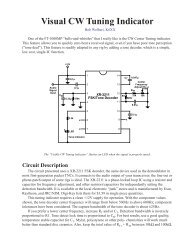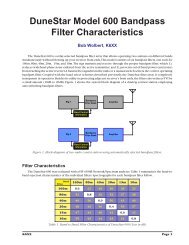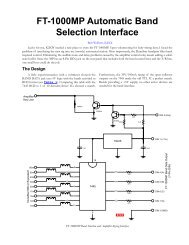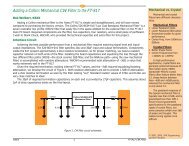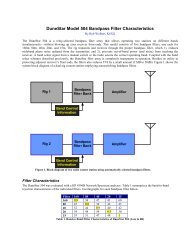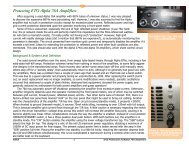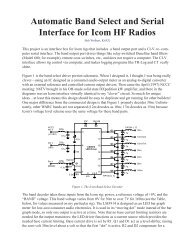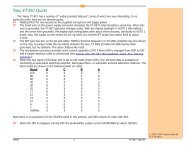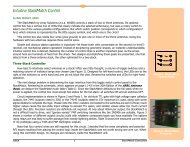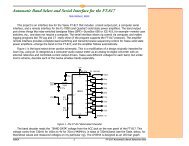Kenwood-to-PC Serial Interface - K6xx.com
Kenwood-to-PC Serial Interface - K6xx.com
Kenwood-to-PC Serial Interface - K6xx.com
- No tags were found...
You also want an ePaper? Increase the reach of your titles
YUMPU automatically turns print PDFs into web optimized ePapers that Google loves.
Simple, Low Cost <strong>Interface</strong> Between <strong>Kenwood</strong> <strong>Serial</strong> Portsand Contest Logging ProgramsBy Bob Wolbert, K6XX (ex-N6IP)A circuit that connects an IBM ® <strong>com</strong>patible personal <strong>com</strong>puter, running TR Log or CT (etc.) contest loggingsoftware, and <strong>Kenwood</strong> transceivers equipped with serial control ports. CW keying is also provided in thisRFI filtered interface unit. No batteries or external power supplies are required.Author Note: This article was written in 1990 for the JUG, the monthly newsletter of the Northern California ContestClub (NCCC). I have updated it (January 1997) a bit, but it still is a bit dated. I believe that CT now uses a differentparallel port CW interface so the keying portion of the interface circuit may not work with the latest CT revision(s).Caveat Emp<strong>to</strong>r—I have been using TR!Packet TNCIBM <strong>PC</strong> or<strong>com</strong>patibleCOM1COM2LPT1CT-TS <strong>Interface</strong>boxSERIALCONTROLKEY<strong>Kenwood</strong> TS-950or similarFigure 1. The <strong>com</strong>puter <strong>com</strong>manded contest station.IntroductionContest logging programs, working with genericradios, are a tremendous improvement over pencil andpaper. Dupe and partial checking in milliseconds, displayingrunning scores, instant (usually) determining ofcountries and zones, and, of course, log printing anderror-free scoring at the end of the contest. IntegratedCW keying make working stations simpler and helpsreduce error rates.But that's not all. When the logging program interfaceswith a <strong>com</strong>puter-<strong>com</strong>patible transceiver, a host ofother features be<strong>com</strong>e available. Band-mapping stations,with the time and frequency au<strong>to</strong>matically entered,is a great aid <strong>to</strong> search-and-pounce operation. Ifyou use packet, on-screen packet spots with fast QSY<strong>to</strong> the spot frequency is another potential score booster.This integration of logging/duping/scoring, band mapping,packet spotting, and CW memory keying with rigfrequency control is available <strong>to</strong> those of us with a<strong>com</strong>puter <strong>com</strong>patible transceiver, a contest loggingprogram, and an interface that connects the other two.I cannot help you with the rig or software, but with thesimple, low cost interface described here, you can savethe $100 that <strong>Kenwood</strong> charges for their RS-232 converterplus whatever the CW keying interface may cost.This one-transis<strong>to</strong>r interface can be easily built in anevening, and provides full <strong>com</strong>patibility with the IBM ®<strong>PC</strong> and <strong>Kenwood</strong> radios (TS-140, TS-440, TS-940, orlater). Better yet, no external power supply is required.The <strong>Kenwood</strong> IF-232 <strong>Interface</strong> BoxFor about $100, <strong>Kenwood</strong> will gladly supply youwith an interface box that allows connecting your serial<strong>com</strong>patiblerig <strong>to</strong> a <strong>PC</strong>. Inside this box is (at most) $5worth of <strong>com</strong>ponents which provide three functions:• TTL <strong>to</strong> RS-232 Line Driving & Receiving• RFI Isolation• Power SupplyFour lines (plus ground) are connected: TXD (TransmitData, inverted), RXD (Receive Data, inverted), RTS(Ready To Send), and CTS (Clear <strong>to</strong> Send). For RFIisolation, <strong>Kenwood</strong> employs op<strong>to</strong>isola<strong>to</strong>rs and separatesradio ground from the interface box chassisground. <strong>Interface</strong> and <strong>com</strong>puter grounds are <strong>com</strong>mon.<strong>PC</strong> <strong>to</strong> TS <strong>Interface</strong> 1 K6XX
Double inversion is provided, so the input signals arethe same sense as the output signals, merely isolatedand level shifted.EIA RS-232CThe most <strong>com</strong>mon serial port used in <strong>com</strong>puters isthe RS-232C. It <strong>com</strong>municates with modems, mice,and some printers, for example. Specification standardsdenote that the line is driven with differentialvoltages ranging from ± 3V <strong>to</strong> about ±15V. The currentand voltage levels are such that 15m of cable can bereliably driven at over 19.6kbps. As far as we areconcerned, this is tremendous overkill for our applicationat 4800bps and less than 15 feet. Thus, we can takegreat liberties and still maintain reliable <strong>com</strong>munications.The line drivers and receivers almost universallyemployed for TTL level (0V <strong>to</strong> +5V) <strong>to</strong> RS-232 (–3V <strong>to</strong>+3V through –15V <strong>to</strong> +15V) level conversion are the1488 and 1489A. These integrated circuits are inexpensiveand available from numerous sources; even betteris the fact that every other solution for this application is100% <strong>com</strong>patible with the 1488/1489A as well as <strong>com</strong>patiblewith RS-232 specifications. This passive interfaceexploits this subtle difference.RS-232 Cable <strong>to</strong> <strong>PC</strong> <strong>Serial</strong> Port(DB25F Connec<strong>to</strong>r)Pin Number2 (RXD)<strong>Kenwood</strong> 6-Pin DINPin Number3 (RXD)3 (TXD)2 (TXD)4 (CTS)4 (CTS)5 (RTS)5 (RTS)7 (GND)1 (GND)Figure 2. The simple interface.The 1489A line receiver uses a diode clamp <strong>to</strong> limitthe negative swing of the differential signal. It simplyclamps the negative voltage <strong>to</strong> about –0.7V internally.It turns out that the “Low” voltage threshold is about+1.0V—in other words, a negative voltage is not evennecessary—0V or +0.9V will provide a logic low ascertainly as will –15V. Combining this fact with<strong>Kenwood</strong>’s double inversion design means that wemust only limit the positive and negative voltage swingsof the RS-232 line for protection of the TTL parts.Clamping the voltage <strong>to</strong> about +5V and 0V (or –0.7V)will serve. Also, the TTL outputs of the <strong>Kenwood</strong> interface,which have 1kΩ pull-up resis<strong>to</strong>rs, provide sufficientswing <strong>to</strong> drive the serial line receivers directly. Thefour line converter can be as simple as is shown inFigure 2.Full functionality is achieved with this circuit, althoughsome <strong>com</strong>puter noise is injected in<strong>to</strong> the rig.Noise reduction is ac<strong>com</strong>plished through pi low-passfilters <strong>to</strong> isolate the rig from the <strong>PC</strong>. The <strong>com</strong>puter andradio ground connections are isolated at RF by anencapsulated choke. The other lines have 0.01µF discceramic capaci<strong>to</strong>rs from each input <strong>to</strong> their respectiveground, plus a series encapsulated choke.Guys that design <strong>com</strong>puter buss’ for a living mightbe in cardiac arrest at this point, but heck, it does thejob, is simple (hence reliable), cheap, needs no power,and does not raise receiver noise level.CW Keying <strong>Interface</strong>Taking full advantage of the <strong>com</strong>puter interfacenecessitates using the printer port for CW keying. Allfour serial ports are spoken for, with the rig, mouse,TNC, and network each requiring their own. This interfaceuses a separate three line cable <strong>to</strong> the <strong>PC</strong> parallel<strong>PC</strong> <strong>to</strong> TS <strong>Interface</strong> 2 K6XX
printer port. A miniature coax cable connects <strong>to</strong> the keyjack of the rig. This circuit uses the only active device inthe entire interface, the keying transis<strong>to</strong>r.The <strong>com</strong>plete schematic is shown in Figure 3.Layout and ConstructionThe major consideration for this low frequency, lowvoltage circuit is RF noise control. We must isolate the<strong>com</strong>puter-generated digital noise from the receiver,and keep RF power away from the <strong>com</strong>puter. I used twoseparate grounds, one for the rig, the other for the<strong>com</strong>puter. Gluing two strips of <strong>PC</strong> board material <strong>to</strong> apiece of perf-board provides two ground surfaces plusmounting space for the <strong>com</strong>ponents.Layout is simple; remember your primary goal isRFI reduction. Do not neglect the bypass capaci<strong>to</strong>rs,and do not stack the solenoidal chokes close <strong>to</strong>gether.The zener diodes return <strong>to</strong> <strong>com</strong>puter ground. Keep<strong>com</strong>ponent values within a fac<strong>to</strong>r of two for best results.Any (working!) NPN transis<strong>to</strong>r will switch the low voltagekey line. There isn't much circuity, so little can gowrong. If it won't play, check the cable pin connections.It is amazingly easy <strong>to</strong> mirror-image connect the DINplug.No buffering is provided with this passive interface,so do not expect <strong>to</strong> run cables for miles. No connec<strong>to</strong>rswere used on the interface box. Connec<strong>to</strong>rs shown inthe schematic mate with rig and <strong>com</strong>puter jacks. I putmy interface about midway between <strong>PC</strong> and rig, a <strong>to</strong>talcable run of about twelve feet, six years ago. I haven't<strong>to</strong>uched it since!© 1991, 1997, Bob Wolbert, K6XX1 kΩ(RXD) 23 (TXD)(TXD) 32 (RXD)Parallel DB25M <strong>Serial</strong> DB25F(CTS) 4(RTS) 5(GND) 718 (GND)1(STROBE)1 kΩ4.7 kΩ4 (RTS)5 (CTS)1 (GND)Key Line6-Pin DIN17 (SLCT)Parts ListFigure 3. The <strong>com</strong>pleted interface, with noise reduction measures and CW keying.Connec<strong>to</strong>rsQuantity6-Pin DIN (Rig) 1DB25M (Parallel port) 1DB25F or DB9F (<strong>Serial</strong> port) 1DeviceQuantityNPN Transis<strong>to</strong>r 1Zener Diode, 3.5V <strong>to</strong> 5.1V 24.7kΩ Resis<strong>to</strong>r 11kΩ Resis<strong>to</strong>r 2100µH RF Chokes,plastic encapsulated 60.01µF Disc ceramic capaci<strong>to</strong>rs 9<strong>PC</strong> <strong>to</strong> TS <strong>Interface</strong> 3 K6XX




